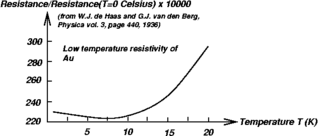Kondo effect

In
Theory
The dependence of the resistivity on temperature , including the Kondo effect, is written as
where is the residual resistivity, the term shows the contribution from the
Background
Kondo's solution was derived using perturbation theory resulting in a divergence as the temperature approaches 0 K, but later methods used non-perturbative techniques to refine his result. These improvements produced a finite resistivity but retained the feature of a resistance minimum at a non-zero temperature. One defines the Kondo temperature as the energy scale limiting the validity of the Kondo results. The Anderson impurity model and accompanying Wilsonian renormalization theory were an important contribution to understanding the underlying physics of the problem.[4] Based on the Schrieffer–Wolff transformation, it was shown that the Kondo model lies in the strong coupling regime of the Anderson impurity model. The Schrieffer–Wolff transformation[5] projects out the high energy charge excitations in the Anderson impurity model, obtaining the Kondo model as an effective Hamiltonian.

The Kondo effect can be considered as an example of asymptotic freedom, i.e. a situation where the coupling becomes non-perturbatively strong at low temperatures and low energies. In the Kondo problem, the coupling refers to the interaction between the localized magnetic impurities and the itinerant electrons.
Examples
Extended to a lattice of magnetic ions, the Kondo effect likely explains the formation of
The Kondo effect has been observed in quantum dot systems.[6][7] In such systems, a quantum dot with at least one unpaired electron behaves as a magnetic impurity, and when the dot is coupled to a metallic conduction band, the conduction electrons can scatter off the dot. This is completely analogous to the more traditional case of a magnetic impurity in a metal.
Band-structure hybridization and flat band topology in Kondo insulators have been imaged in angle-resolved photoemission spectroscopy experiments.[8][9][10]
In 2012, Beri and Cooper proposed a topological Kondo effect could be found with Majorana fermions,[11] while it has been shown that quantum simulations with ultracold atoms may also demonstrate the effect.[12]
In 2017, teams from the Vienna University of Technology and Rice University conducted experiments into the development of new materials made from the metals cerium, bismuth and palladium in specific combinations and theoretical work experimenting with models of such structures, respectively. The results of the experiments were published in December 2017
References
- .
- .
- from the original on August 31, 2020. Retrieved October 13, 2021.
- ]
- S2CID 55838235.
- S2CID 5139144.
- ^ "Revival of the Kondo" (PDF).
{{cite journal}}: Cite journal requires|journal=(help) - .
- PMID 24346502.
- ISBN 978-3-527-68159-4, retrieved 2020-04-26
- S2CID 45712589.
- S2CID 118610269.
- PMID 28665644.
- PMID 29255021.
- ^ Gabbatiss, J. (2017) "Scientists discover entirely new material that cannot be explained by classical physics", The Independent
External links
- Kondo Effect - 40 Years after the Discovery - special issue of the Journal of the Physical Society of Japan
- The Kondo Problem to Heavy Fermions - Monograph on the Kondo effect by A.C. Hewson (ISBN 0-521-59947-4)
- Exotic Kondo Effects in Metals - Monograph on newer versions of the Kondo effect in non-magnetic contexts especially (ISBN 0-7484-0889-4)
- Correlated electrons in δ-plutonium within a dynamical mean-field picture, Nature 410, 793 (2001). Nature article exploring the links of the Kondo effect and plutonium











